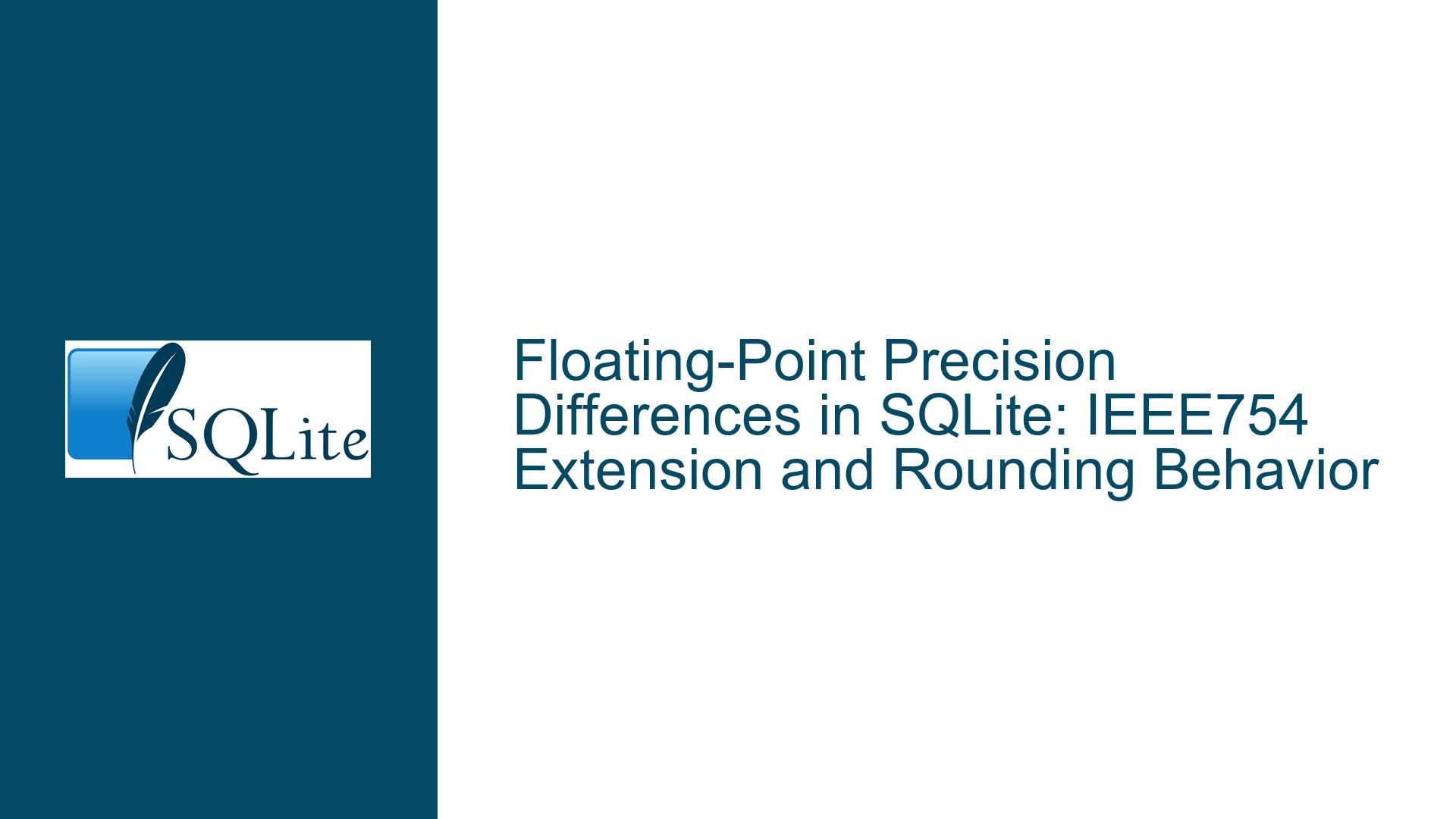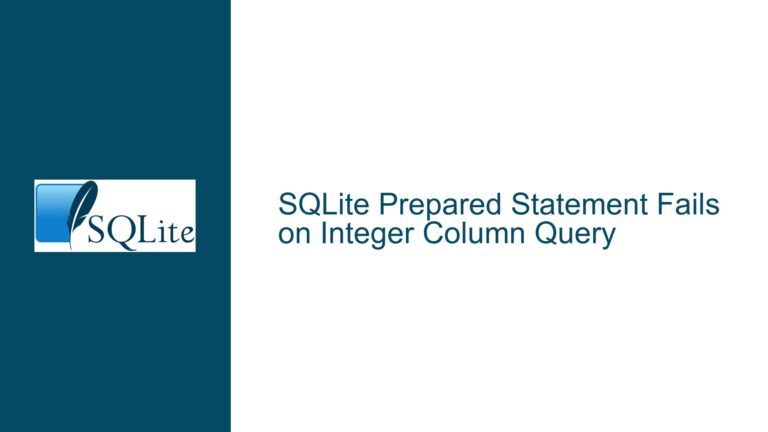Floating-Point Precision Differences in SQLite: IEEE754 Extension and Rounding Behavior
Floating-Point Precision Differences in SQLite: IEEE754 Extension and Rounding Behavior
Understanding Floating-Point Precision and Rounding Differences in SQLite
Floating-point precision is a critical aspect of database systems, especially when dealing with geographic or scientific data where even the smallest discrepancies can lead to significant errors. SQLite, being a lightweight and widely-used database engine, handles floating-point numbers using the IEEE 754 standard, which is the most common representation for floating-point numbers in modern computing. However, the way SQLite processes and stores these numbers can sometimes lead to unexpected differences, particularly when data is imported from different sources or processed using different programming languages.
In the context of SQLite, floating-point numbers are stored as 64-bit doubles, which provide a high degree of precision. However, this precision can sometimes be a double-edged sword. When data is imported into SQLite from different sources, such as Python and C, subtle differences in how these languages handle floating-point rounding can lead to discrepancies in the stored values. These discrepancies are often minimal, sometimes as small as a single Unit in the Last Place (ULP), but they can still cause confusion when comparing data across different sources.
The IEEE 754 standard defines several rounding modes, including "round to nearest, ties to even" (also known as "round half to even") and "round to nearest, ties away from zero" (also known as "round half away from zero"). These rounding modes can produce slightly different results when converting floating-point numbers from text or other formats. In SQLite, the default rounding behavior is "round to nearest, ties to even," which is generally considered the most accurate and unbiased rounding method. However, other languages or libraries might use different rounding modes, leading to the small discrepancies observed when comparing data imported from different sources.
The Role of the IEEE754 Extension in SQLite
To better understand and diagnose these floating-point discrepancies, SQLite provides an extension called IEEE754, which includes functions for converting floating-point numbers to their binary representation and vice versa. This extension is particularly useful for debugging and analyzing floating-point data, as it allows developers to inspect the exact binary representation of a floating-point number, which can reveal subtle differences that are not visible in the decimal representation.
The IEEE754 extension includes functions such as ieee754_to_blob(), which converts a floating-point number to its binary representation as a BLOB, and ieee754_from_blob(), which converts a binary BLOB back to a floating-point number. These functions are invaluable for diagnosing issues related to floating-point precision, as they allow developers to compare the exact binary representation of numbers stored in different databases or processed by different programs.
Despite its utility, the IEEE754 extension is not well-documented in the SQLite CLI documentation. This can make it difficult for developers to discover and use these functions when they are needed. The extension is included by default in the SQLite CLI, but its presence and functionality are not mentioned in the official CLI documentation. This oversight can lead to confusion and frustration for developers who are trying to diagnose floating-point precision issues and are unaware of the tools available to them.
Diagnosing and Resolving Floating-Point Precision Issues
When dealing with floating-point precision issues in SQLite, the first step is to identify the source of the discrepancies. This can be done by comparing the binary representation of the floating-point numbers using the IEEE754 extension. By converting the numbers to their binary representation, developers can see exactly where the differences lie and determine whether they are due to rounding differences or other factors.
Once the source of the discrepancies has been identified, the next step is to decide how to handle them. In many cases, the differences are so small that they have no practical impact on the application. However, if the discrepancies are causing issues, there are several strategies that can be used to resolve them.
One approach is to normalize the data by rounding or truncating the floating-point numbers to a fixed number of decimal places. This can be done using SQLite’s built-in functions, such as ROUND() or by multiplying the numbers by a power of 10, converting them to integers, and then dividing them by the same power of 10. This approach can reduce the precision of the data, but it can also eliminate the small discrepancies caused by different rounding modes.
Another approach is to use a custom rounding function that ensures consistent rounding behavior across all data sources. SQLite allows developers to define their own user-defined functions (UDFs), which can be used to implement custom rounding logic. For example, a UDF could be created to round numbers using the "round to nearest, ties away from zero" method, which is the default rounding mode in Python. By using a custom rounding function, developers can ensure that all data is rounded consistently, regardless of the source.
In some cases, it may be necessary to accept the small discrepancies and adjust the application logic to handle them. For example, if the discrepancies are due to different rounding modes in different programming languages, the application could be designed to treat numbers that are within a certain tolerance as equal. This approach can be more complex to implement, but it allows the application to handle the discrepancies without losing precision.
Best Practices for Handling Floating-Point Data in SQLite
To avoid floating-point precision issues in SQLite, it is important to follow best practices when working with floating-point data. One of the most important best practices is to be aware of the limitations of floating-point arithmetic and to design the application accordingly. Floating-point numbers are inherently approximate, and small discrepancies can arise due to rounding, conversion, and other factors. By understanding these limitations, developers can design applications that are robust and resilient to small discrepancies.
Another best practice is to use the IEEE754 extension to diagnose and analyze floating-point precision issues. The functions provided by this extension can reveal subtle differences in the binary representation of floating-point numbers, which can help developers identify the source of discrepancies and determine the best way to handle them. Even though the extension is not well-documented, it is a powerful tool that should not be overlooked.
When importing data into SQLite from different sources, it is important to be aware of the rounding behavior of the source language or library. If the source uses a different rounding mode than SQLite, small discrepancies can arise. To avoid these discrepancies, it may be necessary to normalize the data by rounding or truncating it to a fixed number of decimal places before importing it into SQLite. This can help ensure that the data is consistent and free from small discrepancies.
Finally, it is important to document the handling of floating-point data in the application. This includes documenting the rounding behavior, the use of the IEEE754 extension, and any custom rounding functions or tolerance levels used in the application. By documenting these details, developers can ensure that the application is maintainable and that future developers will be able to understand and work with the floating-point data.
Conclusion
Floating-point precision issues can be a source of confusion and frustration for developers working with SQLite. However, by understanding the underlying causes of these issues and using the tools available in SQLite, such as the IEEE754 extension, developers can diagnose and resolve these issues effectively. By following best practices and being aware of the limitations of floating-point arithmetic, developers can ensure that their applications handle floating-point data accurately and consistently.
The IEEE754 extension is a powerful tool for diagnosing floating-point precision issues, but its lack of documentation in the SQLite CLI can make it difficult for developers to discover and use. By improving the documentation and raising awareness of this extension, the SQLite community can help developers better understand and work with floating-point data in SQLite.
In summary, floating-point precision issues in SQLite are often caused by differences in rounding behavior between different programming languages or libraries. These issues can be diagnosed using the IEEE754 extension, which provides functions for converting floating-point numbers to their binary representation. Once the source of the discrepancies has been identified, developers can use a variety of strategies to resolve them, including normalizing the data, using custom rounding functions, or adjusting the application logic to handle small discrepancies. By following best practices and being aware of the limitations of floating-point arithmetic, developers can ensure that their applications handle floating-point data accurately and consistently.






